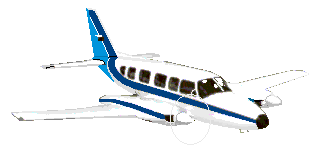|
“St. Thomas Tower this is Eastern Caribbean uh five nine nine one two
Navajo fifteen [miles] south for landing.”
“Eastern Caribbean nine twelve,” replied the tower controller, William
Kittinger, “report Little Saba, right traffic runway nine . . .”
Rivers acknowledged he would report passing Little Saba island.
At 6:43 p.m. radar pinpointed Rivers Navajo as 14 miles south of the airport.
“. . .I suggest you, uh, do you have, uh, Bingo intersection on your chart?” asked Kittinger. “If you, uh, come direct from your present position to Bingo you should be clear of the precipitation,” he further advised.
Rivers rogered the course suggestion. A light rain shower continued from broken clouds nearby. It was nothing remarkable. They were easy to avoid and were speeding past St. Thomas. Big blotches of star studded sky were all about.
At 6:48 p.m. Rivers reported inside Little Saba, the islet which is about 2 ½ nautical miles southwest of the airport. This short, routine flight was almost over.
William A. Kittinger, from whose eyewitness account NTSB investigators were able to put together the final chain of events, remembers at this point spotting the Navajo off the island. Its red and green lights were clearly visible, blinking.
Kittinger cleared him for landing at Runway 9, telling him that a Heron DH114 would be leaving the airfield just prior to his landing.
“Uh, Roger,” responded Rivers casually.
Meanwhile the Heron departed the field. Kittinger visually spotted Rivers’ Navajo off the island again, then routinely glanced back at his radarscope. When he glanced back out the tower windows, he could no longer see the Navajo. Turning back to the radarscope confirmed he had been witness to an extraordinary event; it was blank except for the Heron climbing altitude. Each revolution of the radar monitor hand confirmed it.
“Eastern Caribbean 912, St. Thomas; I’ve lost sight of you, say your position.”
It was silent. Kittinger immediately declared an emergency. The alarms rang out at the Coast Guard station and at Roosevelt Roads Naval Base. Choppers were in the air at 7:05 p.m. and the cutters Point Whitehorn and Saltspray were at the scene. A Cessna 172 on approach immediately followed Rivers’ course and tried to spot any sign. Nothing was ever found, even though the plane must have been a mile from landing.
As in every other disappearance, an electronic shroud accompanied Rivers to his end, the report so stating officiously: “No ELT signals were heard following the loss of the radar target of the aircraft involved.”
Whatever Rivers experienced in that short interim of time, it was believed his experience should have qualified him to handle it. He had 5,342 total flying time hours. The conclusion was by now the very familiar and Spartan: “aircraft damage and injury index presumed”— something more or less obvious.
|
